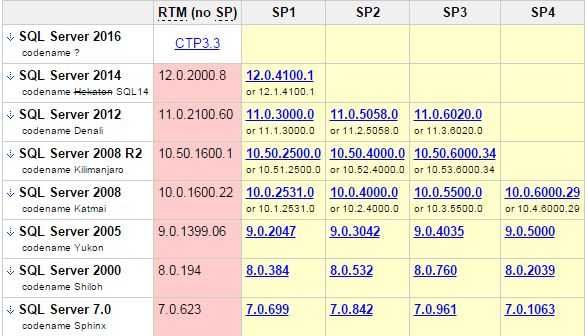—DbStatus
SELECT name, database_id, state_desc, recovery_model_desc
FROM SYS.DATABASES where state_desc <> ‘ONLINE’
—Uptime
Select CONVERT(CHAR(25),login_time,100), CONVERT(CHAR(25), DATEDIFF(DAY, login_time, GETDATE()))
FROM master..sysprocesses
WHERE spid = 1
—Backup
Select SUBSTRING(s.name,1,40) AS ‘Database’,
CAST(b.backup_start_date AS datetime) AS ‘LastBackupDate’, CASE Type WHEN ‘D’ THEN ‘Full’ WHEN ‘L’ THEN ‘Transaction Log’ WHEN ‘I’ THEN ‘Differential’ WHEN ‘F’ THEN ‘FileGroup’ END AS BackupType
FROM master..sysdatabases s LEFT OUTER JOIN msdb..backupset b
ON s.name = b.database_name AND b.backup_start_date = (SELECT MAX(backup_start_date)
FROM msdb..backupset WHERE database_name = b.database_name and s.name <> ‘tempdb’)
order by LastBackupDate
—Errorlogs
exec master..xp_readerrorlog 0, 1, ‘cannot obtain a LOCK’
exec master..xp_readerrorlog 0, 1, ‘Error’
exec master..xp_readerrorlog 0, 1, ‘fail’
exec master..xp_readerrorlog 0, 1, ‘Victim Resource’
exec master..xp_readerrorlog 0, 1, ‘Expire’
exec master..xp_readerrorlog 0, 1, ‘stack’
exec master..xp_readerrorlog 0, 1, ‘CImageHelper’
exec master..xp_readerrorlog 0, 1, ‘is full’
exec master..xp_readerrorlog 0, 1, ‘cannot’
exec master..xp_readerrorlog 0, 1, ‘hung’
exec master..xp_readerrorlog 0, 1, ‘WARNING’
exec master..xp_readerrorlog 0, 1, ‘Unable’
exec master..xp_readerrorlog 0, 1, ‘Could not allocate new page’
exec master..xp_readerrorlog 0, 1, ‘attempting to unlock unowned’
exec master..xp_readerrorlog 0, 1, ‘restored’
exec master..xp_readerrorlog 0, 1, ‘kill’
exec master..xp_readerrorlog 0, 1, ‘Severity: 17’
exec master..xp_readerrorlog 0, 1, ‘Severity: 18’
exec master..xp_readerrorlog 0, 1, ‘Severity: 19’
exec master..xp_readerrorlog 0, 1, ‘Severity: 20’
exec master..xp_readerrorlog 0, 1, ‘Severity: 21’
exec master..xp_readerrorlog 0, 1, ‘Severity: 22’
exec master..xp_readerrorlog 0, 1, ‘Severity: 23’
exec master..xp_readerrorlog 0, 1, ‘Severity: 24’
exec master..xp_readerrorlog 0, 1, ‘Severity: 25’
exec master..xp_readerrorlog 0, 1, ‘Backup Failed’
exec master..xp_readerrorlog 0, 1, ‘SqlDumpExceptionHandler’
exec master..xp_readerrorlog 0, 1, ‘Table corrupt’
exec master..xp_readerrorlog 0, 1, ‘admin’
exec master..xp_readerrorlog 0, 1, ‘cannot obtain a LOCK’
exec master..xp_readerrorlog 0, 1, ‘Severity: 17’
–Jobs
SELECT name, date_modified, last_run_date, last_run_outcome
FROM msdb.dbo.sysjobs A, msdb.dbo.sysjobservers B
WHERE A.job_id = B.job_id and enabled = 1 and last_run_outcome = 0

